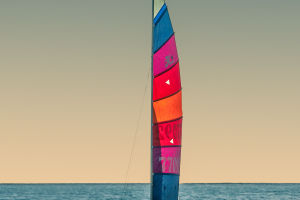Paragliding is an extreme sport that combines free flight, adventure, and natural beauty. With simple equipment and unique aerodynamic principles, it allows flyers to soar through the air, as free as a bird.
The process of paragliding is a combination of science and technology. From takeoff to flight and finally to landing, each stage requires precise control of airflow, the paraglider’s structure, wind speed, and other factors.
The principle of paragliding is based on the balance between lift and gravity in aerodynamics. When the paraglider is lifted into the air, it catches the wind and generates lift as the airflow pushes it.
The shape of the paraglider is similar to the wing of an airplane, and the difference in air pressure between its upper and lower surfaces provides the necessary lift.
When the flyer accelerates or takes off on a slope, such as a hillside, the paraglider opens, and airflow passes through, allowing the flyer to leave the ground and enter the flying state.
The paraglider's wing is usually made of lightweight yet tough nylon material, and the parachute ropes and flight harness are tightly connected to the wing to ensure stability in the air. The shape and curvature of the wing are crucial to generating lift.
During flight, air flows across the upper and lower surfaces of the wing at different speeds—faster flow and lower pressure above the wing, and slower flow and higher pressure below.
This pressure difference creates the lift that keeps the paraglider suspended in the air. By adjusting the angle, speed, and direction of the wing, the flyer can control altitude, speed, and heading.
During gliding, the flyer relies mainly on natural updrafts to maintain altitude. Updrafts typically occur in specific terrain features, such as hillsides, coastlines, or plains.
These air currents allow the paraglider to rise with the current and extend flight time. If the flyer knows how to catch and use these currents, they can stay aloft longer and fly further.
There are several types of updrafts, with the most common being thermals, hillside air currents, and sea breezes. Thermals form when hot air rises from the ground, especially on sunny days.
Hillside air currents occur when the wind blows over a hill, causing the air to rise along the slope. Flyers can use this to quickly increase altitude. Sea breezes occur when cooler air from the sea blows toward the land, rising as it warms, which is ideal for flying near coastlines.
Though paragliding sounds simple, it requires certain skills and experience. During flight, the flyer can adjust direction and speed by controlling the ropes in their hands. Pulling the left rope turns the paraglider left while pulling the right rope turns it right.
Pulling both ropes simultaneously slows the paraglider and reduces altitude. Since paragliders don't have engines, they rely entirely on airflow and the flyer's operation, making it essential to judge wind speed, weather changes, and terrain.
Experienced flyers can often judge their flight path by observing wind direction, cloud movement, and ground conditions, making adjustments to ensure stable, safe flight.
When the flyer prepares to land, safety and smoothness are crucial. Landing requires controlling airflow and the paraglider, much like during the flight. In preparing to land, the flyer first needs to choose a suitable landing spot, usually a flat, open space without obstacles.
Then, they should gradually lower altitude to ensure enough space and time to adjust when nearing the ground. The key to landing is maintaining a moderate speed—not too fast, which could cause a hard landing and increase injury risk, nor too slow, which could stall the paraglider and lead to a loss of control.
To achieve a smooth landing, the flyer can slow down by gradually pulling both control ropes. This action reduces the lift of the paraglider, lowering flight altitude. As the flyer approaches the ground, they must pull the ropes to break the paraglider, reducing landing speed to a minimum.
Upon touching the ground, the flyer should stay relaxed and use their feet to absorb the impact. If wind speed is high, the flyer may need to land with a short run to maintain balance and avoid falling due to excess momentum.
Paragliding is a fun and thrilling sport, but it requires a high level of skill, experience, and safety awareness. Flyers need to master control techniques, understand airflow dynamics, and stay alert during the flight to respond to any emergencies.
Landing safely and smoothly is just as important as the flight itself. Only by mastering landing techniques can flyers ensure their safety while enjoying the excitement of flying.


